Indonesien |
|
|
|
| Übersicht – Contents: | |
Diese Seite ist Teil des Projektes
Indonesien |
|
|
|
| Übersicht – Contents: | |
Flaggen – Flags: |
|
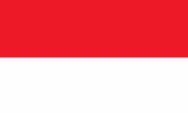 |
National-, Handels und Marineflagge – national, merchant and naval flag, Seitenverhältnis – ratio = 3:5, Quelle/Source, nach/by: Flaggen und Wappen   |
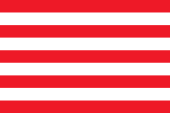 |
Gösch – jack, Seitenverhältnis – ratio = 2:3, Quelle/Source, nach/by: Wikipedia (DE) |
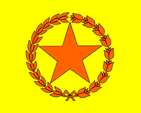 |
Flagge des Präsidenten – flag of the president, Seitenverhältnis – ratio = 4:5, Quelle/Source, nach/by: Flaggen und Wappen |
Bedeutung/Ursprung der Flagge – Meaning/Origin of the Flag: |
|
| Die in den Farben Rot und Weiß horizontal zweigestreifte Flagge wurde seit 1922 in der Unabhängigkeitsbewegung, seit 1927 von der Nationalpartei Indonesiens und seit 1931 von der Partei Indonesiens verwendet, und am 17.08.1945 im Zusammenhang mit der Verkündung der Unabhängigkeit des Staates Indonesien erstmals offiziell gehisst. | The in the colours red and white horizontal double striped flag was in use in the independence movement since 1922, by the National Party of Indonesia since 1927 and by the Party of Indonesia since 1931, and for the first time officially hoisted up in context with the declaration of the independence of the State of Indonesia on the 17th of August in 1945. |
| Die Flagge wird "Merah Putih" genannt, die „Rot-Weiße“. | The flag is called "Merah Putih", the "red-white". |
| Die Farben Rot und Weiß stehen für dualistische Begriffspaare wie irdisch und himmlisch, Tapferkeit und Reinheit, oder Freiheit und Gerechtigkeit. Die Präsidentenflagge ist auch in den Formaten 1:1 und 3:2 bekannt. | The colours red and white stand for dualistic term pairs like worldly and heavenly, bravery and purity, or freedom and justice. The flag of the president is even known in the formats 1:1 and 3:2. |
| Die Farben gehen angeblich auf eine Fahne des Prinzen Jayakatong, des Gründers des Madschapahitreiches, aus dem Jahre 1293 zurück. Diese Fahne zeigte neun waagerechte Streifen in Rot und Weiß. Das Rot in der Flagge ist heute wie folgt definiert: HEX = #ED1C24, RGB = 237|28|36, CMYK = 0|100|100|0 = Pantone 1788. | The
colours go ostensibly back to a flag of the prince Jayakatong – the founder
of the Madjapahit Empire – from the year 1293. That flag showed nine
horizontal stripes in red and white. The red in the flag is defined as follows: HEX = #ED1C24, RGB = 237|28|36, CMYK = 0|100|100|0 = Pantone 1788. |
| Die Gösch des heutigen Indonesiens ist eine Kopie jener Flagge. Indonesien sieht sich selbst als Nachfolger des Madschapahitreiches. | The naval jack of the today's Indonesia is a copy of that flag. Indonesia sees itself as a successor of the Madschapahit Empire. |
| Quelle/Source: Die Welt der Flaggen, Wappen und Flaggen aller Nationen, Flaggen Wappen Hymnen, Flaggen und Wappen der Welt, Wikipedia (EN) | |
Wappen Indonesiens – Coat of Arms of Indonesia: |
|
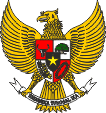 |
Wappen von Indonesien – coat of arms of Indonesia, Quelle/Source: Corel Draw 4 |
Bedeutung/Ursprung des Wappens – Meaning/Origin of the Coat of Arms: |
|
| Das Wappentier Indonesiens ist der Garuda, ein heiliger Vogel der Hindus. Seine 17 Schwung- und 8 Schwanzfedern lassen das Datum der Unabhängigkeit erkennen. Das Brustschild ist gevierteilt mit einem Herzschild in der Mitte, dessen Symbole Glaube an göttliche Prinzipien, Volkssouveränität und nationales Bewusstsein, soziale Gerechtigkeit und die Gleichheit von Mann und Frau bedeuten. Der schwarze Herzschild mit dem goldenen Stern symbolisiert die Verteidigungsbereitschaft. Auf einem Spruchband zwischen den Fängen des Garuda das Staatsmotto: "Bhinneka Tunggal Ika" → "Einigkeit in der Vielfalt". | The
scutcheon animal of Indonesia is the Garuda, a holy bird of the Hindus. It's
17 wing plumes and 8 tail plumes let distinguish the date of independence. The breast shield is quartered with a heart shield in the middle. The in it depicted symbols mean belief in divine principles, people's sovereignty and national awareness, social fairness and the parity of man and woman. The black heart shield with the golden star symbolizes the readiness for defense. On a saying ribbon between the catches of the Garuda the motto of the state: "Bhinneka Tunggal Ika" → "Unity in Diversity". |
| Quelle/Source: Flaggen Wappen Hymnen | |
Flugzeugkokarde – aircraft roundel: |
|
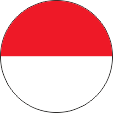 |
1946–1949 Flugzeugkokarde – aircraft roundel Quelle/Source, nach/by Wikipedia (EN) |
 |
seit/from 1949 Flugzeugkokarde – aircraft roundel Quelle/Source, nach/by Wikipedia (EN) |
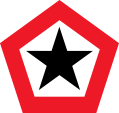 |
seit/from 1949 Flugzeugkokarde für Heeresflieger – aircraft roundel of Army Aviation Quelle/Source, nach/by Wikipedia (EN) |
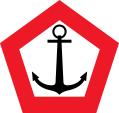 |
seit/from 1949 Flugzeugkokarde für Marineflieger – aircraft roundel for Naval Aviation Quelle/Source, nach/by Wikipedia (EN) |
Landkarten – Maps: |
Lage – Position: |
Landkarte des Landes – Map of the Country: |
Zahlen und Fakten – Numbers and Facts: |
|
|
|
|
|
|
|
|
|
|
|
|
|
|
|
|
|
|
|
|
|
|
|
|
Geschichte: |
| 1500
v.Chr. · erste wichtige Kulturen der eingewanderten Mon-Khmer-Völker, der
Vorfahren der heutigen Indonesier im Gebiet des heutigen Indonesien/Malaysia 300 n.Chr. · Eindringen des Hinduismus, später auch des Bhuddismus ca. 600–ca. 900 · Reich Sriwidschaja auf Sumatra, Malakka, Jawa, Bali und Borneo ca. 700–ca. 950 · Reich von Mataram auf Java 1293–1520 · Reich Madschapahit auf allen Inseln der Region, außer auf den Molukken seit 13. Jhd. · Eindringen des Islam 1509–1512 · beginnende portugiesische Kolonisierung auf Sumatra, Jawa und den Molukken 1521 · die spanische Expedition des Portugiesen Magellan erreicht die Inselwelt Indonesien/Malaysias von Amerika aus, Spanien erhebt jetzt Anspruch auf die Molukken 1529 · der Spanier Saavedra erreicht die Molukken 1529 · Vertrag von Zaragoza, Indonesien/Malaysia werden Portugal zusgesprochen 1586–1830 · islamisches Reich Mataram auf Jawa 1599–1609 · die Niederländer vertreiben die Portugiesen und die Engländer von den Molukken und nehmen diese in Besitz 1602 · Bildung der Niederländischen Ostindienkompanie, welche die Kolonisierung der Region vorantreibt 1610–1641 · die Niederländer vertreiben die Portugiesen aus der gesamten Region, außer aus Osttimor 1619 · Eroberung Djakartas auf Jawa durch die Niederländer, Umbenennung Djakartas in Batavia, Basis für weitere Eroberungen in der gesamten Inselwelt Indonesien/Malaysias im 18. und 19. Jahrhundert 1795 · die Briten erobern die Stadt Malakka 1798 · der niederländische Staat übernimmt die Niederländische Ostindienkompanie 1819 · die Briten erobern Singapur 1828 · die Niederländer erobern Westneuguinea 1847 · die Briten beginnen mit der Kolonisierung von Brunei 1873–1889 · Eroberung der Halbinsel Malakka durch die Briten 1881 · Unterwerfung von Nordborneo durch Großbritannien 1886 · Brunei wird britisches Protektorat 1888 · Unterwerfung von Sarawak durch die Briten 1913 · mit dem Fall des Sultanats Aceh ist die Eroberung Niederländisch-Indiens abgeschlossen 1942 · Japan besetzt Niederländisch-Indien Juni–September 1945 · Vertreibung der Japaner aus Niederländisch-Indien durch Briten und US-Amerikaner (außer von Sumatra), Rückkehr der Niederländer 17.08.1945 · Erklärung der Unabhängigkeit, Ausrufung der Republik Indonesien in Batavia 1945–1947 · Befreiungskrieg Indonesiens gegen die Niederlande 1947 · Vertrag von Linggadjati: Anerkennung der Republik Indonesien auf Jawa, Madura und Sumatra, Abzug aller ausländischen Truppen, Bildung der Vereinigten Staaten von Indonesien 1947–1949 · Bürgerkrieg zwischen Kommunisten, Nationalisten und Separatisten, die Niederlande greifen militärisch ein 27.12.1949 · Vertrag von Den Haag: Gewährung der Unabhängigkeit für ganz Indonesien, außer für Westneuguinea und die Südmolukken, Umwandlung des Landes in eine Föderation, Bindung an die niederländische Krone im Rahmen der Niederländisch-Indonesischen Union 24.03.1950 · die Niederlande gewähren den Südmolukken die Unabhängigkeit, Ausrufung der Republik Südmolukken 17.08.1950 · Ende der Föderation Indonesien, Einführung der zentralistischen Republik 1950–1955 · Eroberung der Republik Südmolukken durch Indonesien 11.08.1954 · Indonesien kündigt die Niederländisch-Indonesische Union 01.10.1962 · Westneuguinea wird von den Niederlanden an die UNO übergeben 01.05.1963 · Westneuguinea wird von der UNO an Indonesien übergeben 1963–1966 · Auseinandersetzungen mit Malaysia 1965 · kommunistischer Putschversuch 07.12.1975 · Besetzung der portugiesischen Kolonie Ost-Timor 17.07.1976 · Einverleibung der portugiesischen Kolonie Ost-Timor als 27. Provinz Indonesiens 1985 · Kämpfe in Ost-Timor 1998 · Kämpfe in Aceh 1991 · Kämpfe in Ost-Timor Januar 1999 · Kämpfe auf den Südmolukken 1999 · Volksabstimmung über Unabhängigkeit in Ost-Timor 2000 · Kämpfe in Aceh 2000 · Kämpfe auf den Südmolukken 2001 · Irian Jaya (Westneuguinea) erhält Autonomiestatus 20.05.2002 · Ost-Timor (Timor-Leste) wird unabhängig 2003 · Kämpfe in Aceh |
History: |
| 1500 B.C.
· first potent civilizations of the here immigrated Mon-Khmer nations, the
forefathers of the today's Indonesians in the region of the today's
Indonesia/Malaysia 300 B.C. · penetration of Hinduism, later Bhuddism too ca. 600–ca. 900 · Empire of Srivijaya on Sumatra, Malacca, Jawa, Bali and Borneo ca. 700–ca. 950 · Empire of Mataram on Jawa 1293–1520 · Empire of Majapahit on all islands in the region, except the Moluccas since the 13th cent. · penetration of the Islam 1509–1512 · beginning Portugese colonization on Sumatra, Jawa and the Moluccas 1521 · the Spanish expedition of the Portugese Magellan achieves the islands of Indonesia/Malaysia coming from America, Spain claims now the Moluccas 1529 · the Spaniard Saavedra achieves the Moluccas 1529 · Zaragoza Treaty, Indonesia/Malaysia get awarded to Portugal 1586–1830 · islamic Empire of Mataram on Jawa 1599–1609 · the Dutch banish the Portugese and the Englishmen from the Moluccas and appropriate the islands 1602 · formation of the Dutch East India Company which enforces the colonization of the region 1610–1641 · the Dutch banish the Portugese from the whole region except from East Timor 1619 · conquest of Djakarta on Djawa by the Dutch, rename of Djakarta into Batavia, base for further conquests in the whole island's region of Indonesia/Malaysia in the 18th and 19th century 1795 · the British conquest the town Malacca 1798 · the Netherlands take over the Dutch East India Company 1819 · the British conquest Singapore 1828 · the Dutch conquest Western New Guinea 1847 · the British start the colonization of Brunei 1873–1889 · conquest of the Malacca peninsula by the the British 1881 · subjection of North Borneo by United Kingdom 1886 · Brunei becomes a British protectorate 1888 · subjection of Sarawak by the British 1913 · with the fall of the Sultanate of Aceh is finished the conquest of Netherlands East-Indies 1942 · Japan occupies Netherlands East-Indies June–September 1945 · expulsion of the Japanese out of Netherlands East-Indies by British and US-American troops (except Sumatra), return of the Dutch 17th of August in 1945 · declaration of independence, proclamation of the Republic of Indonesia in Batavia 1945–1947 · war of liberation, Indonesia against the Netherlands 1947 · Linggadjati Treaty: acceptance of the Republic of Indonesia on Jawa, Madura and Sumatra, withdrawal of all foreign troops, formation of the United States of Indonesia 1947–1949 · civil war between communists, nationalists and separatists, the Netherlands intervene militaryly 27th of December in 1949 · Treaty of Den Haag: granting of independence for whole Indonesia, except Western New Guinea and the South Molucca Islands, transformation of the country into a federation, allegiance to the Dutch crown by the framework of the Netherlands Indonesian Union 24th of March in 1950 · the Netherlands grant independence to the South Molucca Islands, proclamation of the Republic of the South Molucca Islands 17th of August in 1950 · end of the Federation of Indonesia, introduction of the centralist republic 1950–1955 · conquest of the Republic of the South Molucca Islands by Indonesia 11th of August in 1954 · Indonesia terminates the Netherlands Indonesian Union 1st of October in 1962 · Western New Guinea gets handed over from the Netherlands to the UN 1st of May in 1963 · Western New Guinea gets handed over from the UN to Indonesia 1963–1966 · quarrels with Malaysia 1965 · attempted communist coup d'état 7th of December in 1975 · occupation of the Portugese colony of East Timor 17th of July in 1976 · incorporation of the Portugese colony of East Timor as 27th province of Indonesia 1985 · struggles in East Timor 1998 · struggles in Aceh 1991 · struggles in East Timor January 1999 · struggles on the South Molucca Islands 1999 · plebiscite about independence in East Timor 2000 · struggles in Aceh 2000 · struggles on the South Molucca Islands 2001 · Irian Jaya (West New Guinea) is granted autonomy status 20th of May in 2002 · independence for East Timor (Timor-Leste) 2003 · struggles in Aceh |
| Quelle/Source: Atlas zur Geschichte, Wikipedia (D), Discovery '97, Weltgeschichte |
Ursprung des Landesnamens – Origin of the Country's Name: |
|
| Der Name "Indonesien" stammt aus der Alt-Griechischen Sprache und ist eine Kombination der Worte "indo" (Indien) und "nesos" (Insel). Ein ähnliches Verfahren wie es bei Polynesien, Mikronesien oder Melanesien zur Anwendung kam. Der Durchbruch für die Wortschöpfung kam im Jahre 1884 mit der Buchreihe "Indonesien" des deutschen Geographen und Ethnologen Adolf Bastian. | The name "Indonesia" comes from the ancient Greek language and is a combination of the words "indo" (India) and "nesos" (island). A similar procedure of word-creation as it was used in Polynesia, Micronesia or Melanesia. The breakthrough for that word creation came in the year 1884 by the book series "Indonesia" from the German geographer and ethnologist Adolf Bastian. |
| Quelle/Source: Wikipedia (DE) | |
historische Flaggen – historical Flags: |
Madschapahit – Majapahit: |
|
 |
bis/to 1520, Flagge von Madschapahit – flag of Majapahit, Quelle/Source, nach/by: Wikipedia (EN) |
|
|
|
| Das hinduistische Reich Majapahit bestand vom Ende des 13. Jahrhunderts bis zum Anfang des 15. Jahrhunderts. Das Hauptgebiet war immer die Insel Java, die umgebende Staaten in ein Vasallenverhältnis zwang und so ein großes Einflussgebiet beherrschte. Dazu gehörten nahezu allen Inseln der Region, die heute zu Indonesien und Malaysia gehören, außer den Molukken und Westneuguinea. Der eindringende Islam und innere Zwistigkeiten führten zur Flucht des letzten Königs nach Bali und zum Untergang des ganzen Reiches, einhergehend mit wirtschaftlichem und kulturellem Niedergang. | The Hindu Empire of Majapahit existed from the end of the 13th century until the beginning of the 15th century. The main area was always the island of Java, which forced the surrounding states into a vassal-state relationship and thus dominated a large area of influence. This included almost all the islands in the region, which now belong to Indonesia and Malaysia, except the Moluccas and Western New Guinea. The invading Islam and inner disputes led to the escape of the last king to Bali Island and to the demise of the whole empire, along going with economic and cultural decline. |
| Quelle/Source: Wikipedia (EN) | |
Mataram: |
|
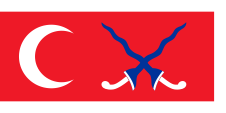 |
1587–1755, Flagge von Mataram – flag of Mataram, Quelle/Source, nach/by: Wikipedia (EN) |
|
|
|
| Das Sultanat Mataram war ein Königreich auf der Insel Java, das zwischen 1586 und 1830 bestand und einigen Einfluss in der Region hatte. Im Kampf gegen die sich ausbreitende Niederländische Ostindien-Kompanie unterlag es letztendlich, wurde 1749 ein Vasallenstaat der Kompanie und endete 1830. | The Sultanate of Mataram was a kingdom on Java Island, which existed between 1586 and 1830. It and had some influence in the region. It lost in the fight against the spreading
Dutch East India Company, became in 1749 a vassal state of the company and ended in 1830. |
| Quelle/Source: Wikipedia (EN) | |
Aceh: |
|
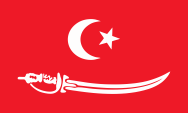 |
1496–1903, Flagge von Aceh – flag of Aceh, Quelle/Source, nach/by: Wikipedia (EN) |
|
|
|
| Das Sultanat Aceh war ein Sultanat in der heutigen gleichnamigen indonesischen Provinz. Es war eine bedeutende regionale Macht im 16. und 17. Jahrhundert, in ständigem Kampf gegen Johre und die Portugiesen. Danach begann eine Epoche des Niedergangs. Zwischen 1873 und 1903 wurde Aceh von den Niederländern erobert. | The Sultanate of Aceh was a sultanate in the Indonesian province with the same name. It was a significant regional power in the 16th and 17th century, in constant battle against
Johre and the Portuguese. After that began an epoch of decline. Between 1873 and 1903 Aceh was conquered by the Dutch. |
| Quelle/Source: Wikipedia (EN) | |
| Mehr Informationen? → hier klicken | more informations → click here |
Republik Südmolukken – Republic of South Molucca Islands (Maluku Selatan): |
|
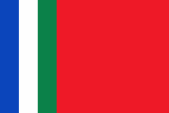 |
1950–1952, Flagge der Südmolukken – flag of South Molucca Islands, Quelle/Source, nach/by: Wikipedia (DE) |
|
|
|
| Die Republik Südmolukken (auch: Südmolukken Ambon, Eigenbezeichnung: Maluku Selatan) bestand zwischen 1950 und 1952 unabhängige Republik. Im Jahre 1952 wurde sie von Indonesien okkupiert. | The Republic of South Molucca Islands (also: Moluccas Ambon, own name: Maluku Selatan) existed between 1950 and 1952 as an independent republic. In the year 1952 it was occupied by Indonesia. |
| Quelle/Source: Wikipedia (DE) | |
| Mehr Informationen? → hier klicken | more informations → click here |
Westneuguinea – Western New Guinea: |
|
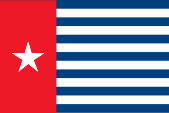 |
Flagge von Westneuguinea – flag of Western New Guinea, Quelle/Source, nach/by: Wikipedia (DE) |
|
|
|
| Westneuguinea (auch: Papua Barat, Irian Barat, Irian Jaya) war bis 1961 eine niederländische Besitzung, der 1961 Selbstverwaltung gewährt wurde. Das Land wurde 1962 der UNO unterstellt, jedoch 1963 von Indonesien annektiert. Seither gibt es hier starke Bestrebungen nach Unabhängigkeit. | Western New Guinea (also called: Papua Barat, Irian Barat, Irian Jaya) was a Dutch possession until 1961, which was granted self-government in 1961. The country was in 1962 handed over to UN, but 1963 it was annexed by Indonesia. Since then, there are strong aspirations for independence. |
| Quelle/Source: Wikipedia (DE) | |
| Mehr Informationen? → hier klicken | more informations → click here |